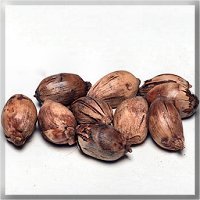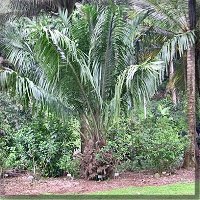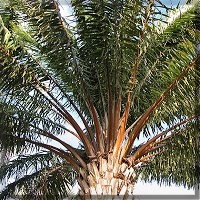


Elaeis oleifera



Elaeis oleifera
Description - The oil palms (''Elaeis'') coomprise two species of the Arecaceae, or palm family. They are used in commercial agriculture in the production of palm oil. The African Oil Palm Elaeis guineensis is native to west Africa, occurring between Angola and Gambia, while the American Oil Palm Elaeis oleifera is native to tropical Central America and South America. Mature trees are single-stemmed, and grow to 20 m tall. The leaves are pinnate, and reach between 3-5 m long. A young tree produces about 30 leaves a year. Established trees over 10 years produce about 20 leaves a year. The flowers are produced in dense clustes; each individual flower is small, with three sepals and three petals. The fruit takes six months to mature from pollination to maturity; it comprises an oily, fleshy outer layer (the pericarp), with a single seed (kernel).
Pharmacology - Palm oil consists mainly of glycerides made up of a range of fatty acids. Triglycerides constitute the major component, with small proportions of diglycerides and monoglycerides. Palm oil also contains other minor constituents, such as free fatty acids and non-glyceride components. This composition determines the oil's chemical and physical characteristics.
About 50% of the fatty acids are saturated, 40% mono-unsaturated, and 10% polyunsaturated. It contains adequate amounts of n-6, 18:2 essential fatty acid. In its content of monounsaturated 18:1 acid, palm oil is similar to olive oil, which is as effective as the more polyunsaturated oils in reducing blood cholesterol and the risk of coronary heart disease. Crude palm oil contains approximately 1% of minor components: carotenoids, vitamin E (tocopherols and tocotrienols), sterols, phospholipids, glycolipids, terpenic and aliphatic hydrocarbons, and other trace impurities [6] (table 2). The most important are carotenoids and vitamin E, both of which possess important physiological properties. The iodine value is between 50 and 56.
Both crude palm oil and carrots are very rich in alpha carotene (30 to 50 percent) while algae (dunaliella carotene) runs about six to 10 percent. Lycopenes have also been identified in low-density lipoprotiens, and therefore may function in the prevention of oxidized LDL in causing atherosclerosis. Although it does not have any provitamin A activity, lycopene is the most efficient biological singlet oxygen quencher of the carotenoids yet discovered, with a quenching efficiency more than two times greater than beta carotene and 100 times greater than vitamin E.
Physiological functions of other carotenoids, as found in crude palm oil, may be highly specialized, as indicated by the presence of zeanthin and its isomer lutein in the macula area of the retina, while beta carotene is virtually absent. It is worthy to note that dark green vegetables are very high in lutien carotenoids. Itís also important to note that crude palm oil cartenoid extract is devoid of any saturated fats, which are normally found in tropical oils.
Contra-indications -